
Audit Report
Follow-up: Minor Children
Receiving Social Security Benefits
Without a Representative Payee
A-13-17-50169 | June 2019
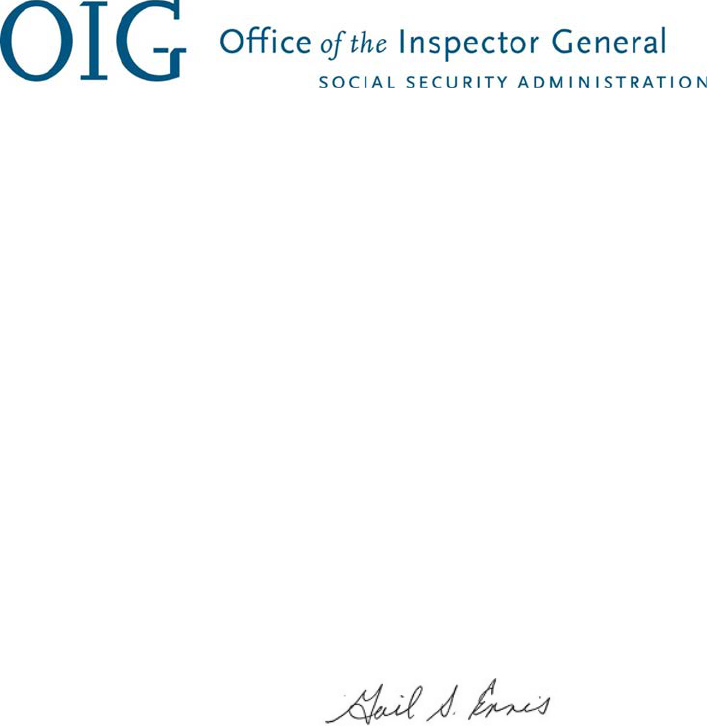
MEMORANDUM
Date:
June 6, 2019
Refer To:
To:
The Commissioner
From:
Inspector General
Subject:
Follow-up: Minor Children Receiving Social Security Benefits Without a Representative Payee
(A-13-17-50169)
The attached final report presents the results of the Office of Audit’s review. The objective was
to determine whether the Social Security Administration complied with its policies when it paid
benefits to minor children.
If you wish to discuss the final report, please call me or have your staff contact Rona Lawson,
Assistant Inspector General for Audit, 410-965-9700.
Gail S. Ennis
Attachment

Follow-up: Minor Children Receiving Social Security Benefits
Without a Representative Payee
A-13-17-50169
June 2019 Office of Audit Report Summary
Objective
To determine whether the Social
Security Administration (SSA)
complied with its policies when it paid
benefits to minor children.
Background
The law requires that most minor
children have representative payees to
manage their benefits to ensure the
payments are used for their current and
foreseeable needs.
SSA generally presumes minor
children under age 18 are incapable of
managing their own benefits. As a
result, SSA usually appoints
representative payees to manage the
benefits of children. However, SSA
can pay a child age 15 through
17 directly if the child meets certain
criteria.
We identified 709 minor children
under age 15 and 1,273 minor children
who were between age 15 and 17 and
5 months as of April 2017 that did not
have appointed representative payees.
We provided a list of the 709 minor
children under age 15 to the Agency
for review and corrective action. In
addition, from the group of children
between the ages 15 and 17 and
5 months, we randomly selected 50 for
review.
Findings
SSA did not always comply with its policies when it paid benefits
to minor children. Of the 709 minor children under age 15 we
identified and referred to SSA for review and corrective action,
SSA confirmed it had not appointed representative payees for
668 as of April 2017. We estimate the Agency paid these children
approximately $12.2 million. For the remaining 41 children, SSA
reported appointing representative payees for 22 before our
referrals, suspending or terminating benefits for 14, and correcting
the dates of birth for 5 who were actually over age 18.
Of the 50 children we reviewed who were between ages 15 and
17 and 5 months, SSA did not comply with its policies for 46 who
received benefits. The Agency confirmed it did not appoint
representative payees for 32 child beneficiaries. Based on our
sample, we estimate the Agency paid 815 child beneficiaries
approximately $22.5 million. Additionally, SSA did not document
capability determinations for 14 children it paid directly as is
required by Agency policy. Based on our sample, we estimate SSA
did not properly document capability determinations for
356 children it paid directly.
Recommendations
We recommend SSA:
1. Direct employees to (1) comply with policies for appointing
representative payees for minor children, (2) document
capability determinations, and (3) adjudicate representative
payee applications properly.
2. Implement a process to periodically identify all children under
age 17 and 5 months being paid directly; and determine and
document whether the Agency needs to appoint representative
payees.
SSA agreed with our recommendations.
Agency Actions Resulting from the Audit
In response to our audit, SSA appointed representative payees for
the children who were still receiving benefits and needed to be
served by representative payees.
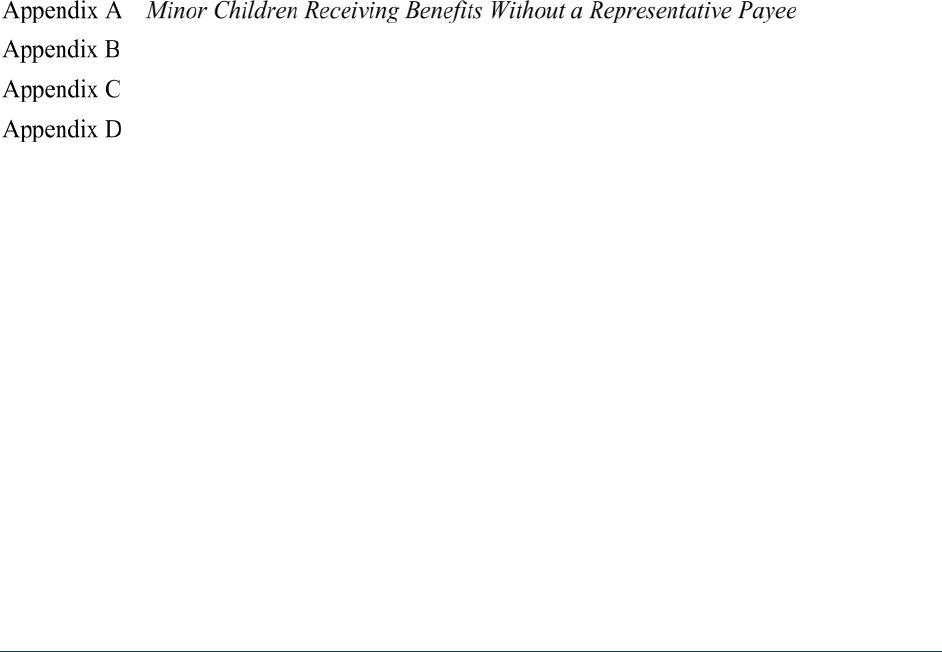
Minor Children Receiving Social Security Benefits Without a Representative Payee (A-13-17-50169)
TABLE OF CONTENTS
Objective ..........................................................................................................................................1
Background ......................................................................................................................................1
Results of Review ............................................................................................................................4
Minor Children Under Age 15 ...................................................................................................4
Children Receiving Benefits Without Representative Payees .............................................5
Benefits Received by Individuals Who Were Not Representative Payees ..........................7
Prior Audit ...........................................................................................................................7
Minor Children Age 15 and Older .............................................................................................8
Children Receiving Benefits Without Representative Payees .............................................8
Capability Determination Policy for Children ...................................................................10
Prior Audit .........................................................................................................................11
Conclusions ....................................................................................................................................11
Recommendations ..........................................................................................................................12
Agency Comments .........................................................................................................................12
Agency Actions Resulting from the Audit .....................................................................................12
– ................ A-1
– Scope and Methodology ..................................................................................... B-1
– Sampling Methodology and Results ................................................................... C-1
– Agency Comments .............................................................................................. D-1

Minor Children Receiving Social Security Benefits Without a Representative Payee (A-13-17-50169)
ABBREVIATIONS
C.F.R. Code of Federal Regulations
eRPS Electronic Representative Payee System
Form SSA-11-BK Request To Be Selected As Payee
OASDI Old-Age, Survivors and Disability Insurance
OIG Office of the Inspector General
POMS Program Operations Manual System
SSA Social Security Administration
SSI Supplemental Security Income
U.S.C. United States Code

Minor Children Receiving Social Security Benefits Without a Representative Payee (A-13-17-50169) 1
OBJECTIVE
Our objective was to determine whether the Social Security Administration (SSA) complied with
its policies when it paid benefits to minor children.
BACKGROUND
Some individuals cannot manage or direct the management of their finances because of their
youth or mental and/or physical impairments. For such beneficiaries, Congress provided for
payment through representative payees who receive and manage benefits for the beneficiaries.
1
A representative payee may be an individual or an organization.
2
SSA selects representative
payees for Old-Age, Survivors and Disability Insurance (OASDI)
3
and Supplemental Security
Income (SSI)
4
beneficiaries
5
when representative payments would serve the beneficiaries’
interests. Approximately 5.8 million payees manage $70 billion in annual benefits for
8.1 million beneficiaries. Fifty-three percent of the beneficiaries are minor children.
6
The law requires that most minor children have representative payees to manage their benefits to
ensure they are used for the children’s current and foreseeable needs.
7
Therefore, SSA generally
presumes minors under age 18 are incapable of managing their own benefits. SSA policy
8
states
a child under age 15 must have a representative payee unless the child is emancipated under
State law. As a result, SSA usually appoints a representative payee to manage a child’s benefits.
1
Social Security Act, 42 U.S.C. §§ 405(j)(1), 1383(a)(2)(A)(ii) (govinfo.gov 2017). See also 20 C.F.R.
§§ 404.2001(b), 416.601(b) (govinfo.gov 2016).
2
20 C.F.R. §§ 404.2001(a), 416.601(a) (govinfo.gov 2016).
3
The OASDI program provides retirement and disability benefits to qualified individuals and their dependents as
well as to survivors of insured workers. See Social Security Act, 42 U.S.C. §§ 402, 423 (govinfo.gov 2017).
4
The SSI program provides payments to individuals who have limited income and resources and are age 65 or older,
blind, or disabled. Social Security Act, 42 U.S.C. § 1381 (govinfo.gov 2017). See also 20 C.F.R. § 416.110
(govinfo.gov 2018).
5
Throughout this report, we use the term “beneficiary” to refer to OASDI beneficiaries and SSI recipients, and the
term “benefits” to refer to OASDI benefits as well as SSI payments.
6
SSA, Annual Report on the Results of Periodic Representative Payee Site Reviews and Other Reviews, p.2 (2018).
7
20 C.F.R. § 416.601-610 (govinfo.gov 2016).
8
SSA, POMS, GN 00502.001, C (January 26, 2017).

Minor Children Receiving Social Security Benefits Without a Representative Payee (A-13-17-50169) 2
However, SSA can pay a child age 15 through 17 directly if the child
is emancipated,
is entitled to disability benefits based on his/her own earnings,
is on active duty in the armed forces,
is living alone and self-supporting,
is a parent and filed for his/her own or his/her child’s benefits and has experience handling
finances,
is within 7 months of attaining age 18, or
has demonstrated the ability to handle his/her finances.
9
Additionally, if SSA determines a child is capable of receiving his/her benefits without a
representative payee,
10
Agency staff must document the results of its capability determination in
the Electronic Representative Payee System (eRPS) or on a Report of Contact if they cannot do
so in eRPS.
11
However, a beneficiary age 15 to 18 can be paid directly on an interim basis even if he/she is
incapable of managing benefits.
12
In these instances, the Agency takes a Form SSA-11-BK,
Request To Be Selected As Payee (SSA 11-BK) and completes follow ups with the beneficiary
every 90 days to ensure the benefits are being used properly.
13
SSA can decide to continue direct
payment permanently if it appears the beneficiary is using the money to meet his/her needs and
no other suitable payee has been found.
14
Representative payees have many responsibilities, including determining beneficiaries’ current
and foreseeable needs; using Social Security benefits in the beneficiaries’ best interest; and
keeping detailed and accurate records of how the payments are used to provide an accurate report
to SSA, if requested.
15
9
SSA, POMS, GN 00502.070, A.1 (January 26, 2017).
10
See Footnote 10.
11
SSA, POMS, GN 00502.065, C (June 29, 2017).
12
SSA, POMS, GN 00504.105, A.2 (July 19, 2017).
13
SSA, POMS, GN 00504.105, B.2 (July 19, 2017).
14
See Footnote 14.
15
SSA, POMS, GN 00502.114, A (February 27, 2014).

Minor Children Receiving Social Security Benefits Without a Representative Payee (A-13-17-50169) 3
SSA replaced the Representative Payee System with eRPS in April 2016 to streamline the
actions and processes for representative payee selections, accounting, and misuse
determinations.
16
The eRPS is intended to help the Agency fulfill its legal duty
17
to investigate
representative payee applicants to determine whether their appointments are in the beneficiaries’
best interests by providing known information about the applicants so SSA can make well-
informed decisions.
18
Further, SSA initiated its automated Sweeper process in December 2017, after it implemented
eRPS. Sweeper reviews applications pending in eRPS and takes action based on case criteria.
Sweeper activates or terminates the appointment of representative payees and closes pending
payee applications in eRPS or identifies necessary actions for pending applications it cannot
automatically clear.
19
SSA staff indicated the Agency used Sweeper monthly.
This review is a followup to our May 2011 report, which stated SSA did not always appoint
representative payees for children under age 15 in accordance with its policies.
20
In addition,
SSA did not comply with its policies and procedures for children age 15 to 17 who managed
their own benefits. Our report included five recommendations, which SSA generally agreed to
implement. See Appendix A for a summary of the prior report.
We identified 1,982 children who were receiving benefits as of April 2017 but did not have
representative payees appointed or were themselves listed as their own representative payees on
their records. Of these, 709 were under age 15, and 1,273 were between age 15 and 17 and
5 months.
21
We referred the 709 children under age 15 to the Agency for review and corrective
action. In addition, we randomly selected 50 children who were between age 15 to 17 and
5 months for review. See Appendix B for our scope and methodology and Appendix C for our
sampling methodology and results.
16
SSA, eRPS – Representative Payee Redesign, ssa.gov (last visited February 5, 2019).
17
Social Security Act, 42 U.S.C. § 405(j)(2)(A)(i) (govinfo.gov 2017).
18
SSA, POMS, GN 00502.120, A (April 15, 2016).
19
SSA, MSS Messages, Electronic Representative Payee System (eRPS) – Maintenance Release Enhancement,
MSS17-146 eRPS (December 14, 2017).
20
SSA, OIG, Minor Children Receiving Benefits Without a Representative Payee, A-13-10-10104 (May 2011).
21
SSA may directly pay children within 7 months of attaining age 18.

Minor Children Receiving Social Security Benefits Without a Representative Payee (A-13-17-50169) 4
RESULTS OF REVIEW
We found instances where SSA did not comply with its policies when it paid benefits to minor
children. As of April 2017, the Agency had not appointed representative payees for
668 children
22
under age 15. We estimate SSA paid these children approximately $12.2 million
even though they did not have representative payees.
23
Of the 1,273 children age 15 through 17 and 5 months,
24
we estimate SSA paid 815
approximately $22.5 million although there were no representative payees on the children’s
records. In addition, we estimate SSA did not properly document capability determinations for
356 children it paid directly.
Minor Children Under Age 15
Of the 709 minor children under age 15 we identified and referred to SSA for review and
corrective action, SSA confirmed it had not appointed representative payees for 668 as of
April 2017.
25
We estimate the Agency paid these children approximately $12.2 million without
representative payees.
26
For the remaining 41 children, SSA appointed representative payees for
22 before our referrals,
27
suspended or terminated benefits for 14, and corrected the dates of birth
for 5 who were actually over age 18.
Furthermore, the Agency provided additional information that indicated instances where
individuals other than the minor children may have received the benefits. Using information and
an analysis method SSA provided, we identified 118 instances, from the 668 records, where
individuals other than the minor children received the children’s benefits. However, coding on
the children’s benefit records did not indicate the children had representative payees. Benefit
record coding shows when SSA appointed the representative payee and the relationship between
the beneficiary and the representative payee. Additionally, the coding allows the Agency to
22
Of the 668 children, we identified 3 during our 2011 audit.
23
Estimated payments cover the following periods: (a) from the time SSA began payments to when SSA appointed
representative payees or (b) from when SSA began payments to June 2018.
24
We found six children from our 2011 audit included in this group of minor children.
25
As of March 2019, SSA had appointed representative payees for 659 children, and 9 children had been suspended
and did not have a representative payee. For children with suspended benefits, SSA should appoint a representative
payee if a child returns to current pay status.
26
See Footnote 24.
27
The 22 children were included in our April 2017 data extract. SSA appointed representative payees for these
children between the date of our extract and the date we referred the 709 children to the Agency.

Minor Children Receiving Social Security Benefits Without a Representative Payee (A-13-17-50169) 5
know whether the representative payee has custody of the beneficiary and determine when SSA
needs to send a representative payee accounting form.
28
,
29
Children Receiving Benefits Without Representative Payees
To determine why SSA paid children under age 15 without appointing representative payees, we
requested the Agency review the 709 cases we identified. SSA confirmed it did not appoint
representative payees for 668 children but should have. The Agency paid the 668 children
approximately $309,000 each month. According to SSA staff, the Agency did not appoint
representative payees for 518 children because of information systems errors,
30
140 children
because of employee processing errors, and 10 children for unknown reasons.
Information Systems Errors
Of the 668 children, the Agency’s review indicated it paid 518 without representative payees
because of information systems errors. SSA paid the children approximately $241,000 each
month.
For 454, representative payee application errors occurred before SSA implemented eRPS.
31
For 61, representative payees were erroneously removed from the children’s benefit records.
For three, eRPS did not properly process representative payee applications.
For example, the father of a 5-year-old beneficiary applied to serve as representative payee in
July 2015, before SSA implemented eRPS. However, because of issues with the Representative
Payee System (the predecessor to eRPS), the Agency did not process the representative payee
application. As a result, SSA issued monthly benefits of $313 to the child. The Agency
appointed the child’s grandmother as representative payee in December 2017.
In another instance, SSA reported a systems error inadvertently removed the representative
payee from an 8-year-old beneficiary’s record. When SSA staff changed the child’s name on the
Numident, staff did not complete a subsequent change to the child’s benefit record. Therefore,
the name change did not synchronize with the child’s eRPS record, which no longer included the
child’s representative payee. The Agency took corrective action and selected the child’s mother
as representative payee.
28
The accounting report is used to monitor how the representative payee spent or saved the benefits on the
beneficiary’s behalf, identify situations where representative payment may no longer be appropriate, or determine
whether the representative payee is no longer suitable.
29
SSA, POMS, GN 00605.020, B (April 15, 2016). This policy was in effect during our audit period. SSA updated
its policy on March 13, 2019.
30
Of the 518 children, 3 were included in our prior audit.
31
Of the 454 children, 3 were included in our prior audit.

Minor Children Receiving Social Security Benefits Without a Representative Payee (A-13-17-50169) 6
In a third instance, SSA approved a benefit claim for an 11-year-old beneficiary in 2016.
According to SSA, the representative payee application recorded in eRPS became “stuck” in
“ready to process” status, and Agency staff subsequently closed the application. To correct the
problem, SSA entered a new representative payee application and selected a representative payee
in eRPS in October 2017.
SSA Employee Processing Errors
SSA explained for 140 children, to whom it paid approximately $64,000 each month, Agency
employees did not always take representative payee applications, select representative payees, or
input the information correctly into SSA’s information systems, as required. This included
63 children for whom SSA did not select representative payees,
41 children for whom SSA did not take representative payee applications, and
36 children for whom SSA improperly coded information in its systems.
For example, the Agency completed a representative payee application for a 9-year-old
beneficiary but did not select and add the representative payee to the child’s benefit claim. SSA
processed the child’s claim and issued benefits without placing the representative payee on the
benefit record.
In another instance, SSA did not take a representative payee application when it completed a
benefit claim for a 5-year-old beneficiary. The Agency paid benefits directly to the child from
June 2013 to January 2018, when SSA appointed the child’s mother as representative payee.
In a third example, in October 2016, the Agency manually processed a benefit claim for a 4-year-
old beneficiary and took a representative payee application for the child’s mother in eRPS. The
representative payee information was not properly coded during manual processing. This coding
problem caused SSA to issue benefits to the child without establishing a representative payee.
The Agency added the representative payee to the child’s benefit record in November 2017.
Unknown Problems
SSA could not determine why it paid 10 children approximately $4,000 each month without
representative payees on their records. In one instance, SSA paid a 1-year-old beneficiary
directly. SSA did not explain how this occurred, but Agency staff did appoint the child’s mother
as her representative payee in July 2017.

Minor Children Receiving Social Security Benefits Without a Representative Payee (A-13-17-50169) 7
Benefits Received by Individuals Who Were Not Representative Payees
SSA provided information that indicated situations where individuals other than the minor
children may have received the children’s benefits. Using information and an analysis method
SSA provided, we re-examined information for the 668 children and identified 118 instances
involving individuals other than the children receiving benefits. For the 118 children, we found
the following.
In 101 instances, SSA had representative payee applications for children before we referred
the records to the Agency for review and corrective action. However, SSA did not fully
process the applications, the representative payees no longer appeared on the records, or we
could not determine why representative payees were not on the children’s benefit records. In
one instance, the Agency obtained a representative payee application for someone other than
the person who received the minor child’s benefit.
In 17 instances, SSA did not obtain representative payee applications.
For example, in June 2015, SSA did not select a woman who applied to be representative payee
for her 11-year-old child; however, the Agency sent her the child’s benefits. After our referral,
SSA selected the child’s mother as representative payee in July 2018.
In another instance, the Agency began the application process for a 10-year-old child’s
representative payee after we referred information for its review. The individual, whom SSA
selected as the child’s representative payee in January 2018, received benefits before SSA took
her application to serve as the child’s representative payee.
Additionally, for 6 of the 118 children, the Agency appointed representative payees who were
not the individuals receiving the children’s benefits. For example, an individual applied in
August 2015 to be representative payee for a 2-year-old child; however, the application was
“stuck” in eRPS. As a result, the individual continued receiving the child’s benefits although the
Agency did not officially select the person as the child’s representative payee. After our referral,
in February 2018, SSA appointed a social agency to serve as the child’s representative payee.
Prior Audit
Our prior audit
32
found SSA did not always appoint representative payees for children under
age 15. We found SSA paid children who did not have representative payees on their records.
We provided the Agency a list of 1,351 children under age 15 without representative payees for
review and corrective action. During our current review, we identified three children from the
prior audit, still under age 15, whom SSA continued paying without representative payees on
their records. We requested SSA review the three cases and take appropriate corrective action.
As of June 2018, the Agency had appointed representative payees for all three children. SSA
had paid these children approximately $89,000 since our prior audit.
32
See Footnote 21.

Minor Children Receiving Social Security Benefits Without a Representative Payee (A-13-17-50169) 8
Minor Children Age 15 and Older
We selected a random sample of 50 children age 15 through 17 and 5 months to review. Of the
50 children, SSA paid 4 in compliance with policy. However, SSA did not comply with its
policies when it paid 46 children who did not have representative payees.
SSA determined 32 children
33
were incapable of managing their own benefits but still issued
them benefits without representative payees on their records.
34
SSA did not properly document, in accordance with policies and procedures, its capability
determinations for 14 children it paid directly.
Based on our sample results, we estimate SSA paid 815 children between ages 15 and 17 and
5 months approximately $22.5 million without representative payees.
35
In addition, we estimate
SSA did not properly document capability determinations for 356 children it paid directly.
Children Receiving Benefits Without Representative Payees
Of the 46 children for whom SSA did not comply with its representative payee policies, the
following 32 included instances where the Agency did not appoint representative payees for
child beneficiaries:
27 involved Agency staff initiating representative payee applications but not processing them
properly;
3 involved systems errors; and
2 involved undocumented parents
36
who wanted to act as representative payees, but SSA did
not complete the representative payee applications.
The Agency paid the 32 children over $883,000 before it appointed representative payees for
them or they turned 18.
37
33
SSA can pay the child directly if the child files his/her own initial claim and a representative payee is not available
when the claim is ready to be processed. However, this exception did not apply to any of the 32 children. See SSA,
POMS, GN 00504.105, A, B.2 (July 19, 2017).
34
We found six children identified in our prior audit whom SSA continued paying without representative payees on
their records.
35
Our sample projection is based on 32 children for whom SSA did not appoint representative payees. See
Appendix C.
36
SSA considers an individual undocumented if he/she cannot provide proof of a lawful presence in the United
States.
37
As of June 2018, of the 32 children, 18 had representative payees appointed, 7 had reached age 18, 6 had their
benefits terminated because they were no longer eligible for benefits, and 1 had his/her benefits suspended for
failing to provide required information to SSA.

Minor Children Receiving Social Security Benefits Without a Representative Payee (A-13-17-50169) 9
Representative Payee Applications Not Processed Properly
Of the 32 children, SSA obtained representative payee applications for 27 but did not process
them properly. According to SSA policy,
38
Agency staff is to administer
39
representative payee
applications in eRPS. For 23 of 27 beneficiaries, SSA did not finish processing representative
payee applications, and the children’s eRPS and/or benefit records did not identify representative
payees. In the remaining four instances, SSA failed to include, as required by the procedures for
manually processing applications, copies of documentation in its automated systems. In 2016,
after SSA stopped using its Representative Payee System and began using eRPS, Agency
technicians did not always follow up on representative payee applications that were in process in
the Representative Payee System.
For example, SSA took a representative payee application in May 2013 for a 15-year-old
beneficiary but did not select the representative payee; therefore, there was no representative
payee on the child’s benefit record. In October 2017, we informed SSA of our review results. In
January 2018, the Agency selected a representative payee for this child.
In another instance, when the Agency attempted to contact a 15-year-old recipient to conduct a
redetermination
40
of the child’s eligibility for benefits, SSA received no response. As of
May 2017, SSA had suspended the child’s benefits. As of June 2018, the child was in non-pay
status.
Additionally, we found two instances where individuals other than the children received benefits.
However, SSA did not select representative payees or record them on the children’s benefit
records. According to Agency staff, “. . . the payments were made to the natural mother.” For
these instances, SSA reported that both were the result of coding errors.
System Errors
SSA paid three children who did not have representative payees because of information system
errors. In one instance, in September 2015, SSA’s information systems removed a 16-year-old
beneficiary’s representative payee. SSA appointed a representative payee for this child in
March 2018.
38
SSA, POMS, GN 00502.110, A, B (November 2, 2016).
39
SSA staff uses eRPS to create new representative payee applications and update pending applications.
40
A change in a person’s income, resources, and/or household composition can affect a person’s eligibility for
benefits and the amount of benefits. The law requires that SSA periodically re-determine an individual’s continuing
eligibility to receive benefits and the amount of benefits.

Minor Children Receiving Social Security Benefits Without a Representative Payee (A-13-17-50169) 10
Representative Payee Applications for Undocumented Parents
There were two instances where Agency staff did not include SSA-11-BKs in the Certified
Electronic Folder. According to SSA policy,
41
Agency staff can appoint undocumented parents
as representative payees. However, eRPS does not accept representative payee applications
without a Social Security number, which serves as the unique identifier in the system. Therefore,
when an undocumented parent wants to serve as a representative payee, the individual must
complete an SSA-11-BK, and the Agency should scan the document into the Non-disability
Repository for Evidentiary Documents system or the Electronic Disability system.
42
The two
SSI recipients we identified had undocumented parents who wanted to serve as representative
payees; however, SSA did not retain the SSA-11-BKs of the undocumented parents in the
Certified Electronic Folder.
The Agency reviewed these two instances and agreed with our conclusion. SSA could not locate
the representative payee applications in its systems for the children’s undocumented parents.
However, we confirmed SSA had appointed representative payees for both children as of
June 2018.
Capability Determination Policy for Children
Generally, SSA is required to make capability determinations regarding whether children ages
15 to 17 can manage their own benefits.
43
The Agency directly pays these children if they meet
certain conditions. According to SSA, staff must make a capability determination based on
legal, medical, or lay evidence. Further, Agency staff must properly document the capability
determination, which includes a concluding statement summarizing the facts considered and the
basis for the determination in eRPS.
SSA staff did not document the children’s capability in accordance with its policies and
procedures. SSA decided to pay benefits to 14 children directly, but staff did not properly
document the capability determination. According to SSA staff, employees intended to pay
benefits to these children directly. The Agency considered these children capable of managing
their own benefits and decided not to develop the children’s records any further.
As of June 2018, we had found
six instances where SSA assumed the child was capable of managing his/her own benefits,
six instances where SSA terminated benefits, and
two instances where the child reached age 18.
41
SSA, POMS, GN 00502.117, A.1.a (June 23, 2017). This policy was in effect during our audit period. SSA
updated its policy on March 30, 2019.
42
SSA, POMS, GN 00502.190, B.1 (November 8, 2018).
43
See Footnote 10.

Minor Children Receiving Social Security Benefits Without a Representative Payee (A-13-17-50169) 11
Prior Audit
During our current review, we identified six children
44
age 15 and older from the prior audit
whom SSA continued to pay without representative payees on their records. We requested SSA
review these instances and take corrective action, as appropriate. SSA confirmed five children
did not have representative payees, and one child was age 18. As of March 2019,
in two instances, SSA appointed a representative payee;
in two instances, SSA continued paying benefits to an individual other than the child (“the
natural mother”) because the children’s records were not coded properly;
in one instance, the beneficiary attained at least age 18; and
in one instance, SSA terminated the child’s benefits.
SSA had paid these children approximately $247,000
45
since we completed our prior audit.
CONCLUSIONS
Similar to our prior audit, we found instances where SSA did not comply with its policies when
it paid benefits to minor children without representative payees. Since our prior review, the
Agency had taken some corrective actions; however, we continued to identify problematic
instances similar to those found in our prior audit. Specifically, the Agency did not appoint
representative payees for 668 children under age 15, as required. We estimate SSA paid these
children approximately $12.2 million without representative payees. The 668 children included
3 from our prior audit.
Our review of a sample of children ages 15 through 17 and 5 months found the Agency did not
appoint representative payees for 32 children in accordance with SSA’s policies and procedures.
Based on our sample results, we estimate SSA paid 815 children approximately $22.5 million
without representative payees. In addition, we estimate SSA did not properly document
capability determinations for 356 children it paid directly. We also found six children from the
prior audit included in this group of minor children and determined the status of Agency actions
as of March 2019.
44
The six children were under age 15 at the time of our 2011 audit report and referred to SSA for review.
45
Of the approximate $247,000 paid to these children from the prior audit, as of March 18, 2019, approximately
$77,000 was paid to the two children until representative payees were appointed, approximately $87,000 was paid to
the two individuals receiving payments other than the child, approximately $24,000 was paid to the one child until
the child reached age 18, and approximately $59,000 was paid to the remaining child until the child’s benefits were
terminated.

Minor Children Receiving Social Security Benefits Without a Representative Payee (A-13-17-50169) 12
RECOMMENDATIONS
We recommend SSA:
1. Direct employees to (1) comply with policies for appointing representative payees for minor
children, (2) document capability determinations, and (3) adjudicate representative payee
applications properly.
2. Implement a process to periodically identify all children under age 17 and 5 months being
paid directly; and determine and document whether the Agency needs to appoint
representative payees.
AGENCY COMMENTS
SSA agreed with our recommendations. The Agency’s comments are included in Appendix D.
AGENCY ACTIONS RESULTING FROM THE AUDIT
In response to our audit, SSA appointed representative payees for the children who were still
receiving benefits and needed to be served by representative payees.
Rona Lawson
Assistant Inspector General for Audit

Minor Children Receiving Social Security Benefits Without a Representative Payee (A-13-17-50169)
APPENDICES
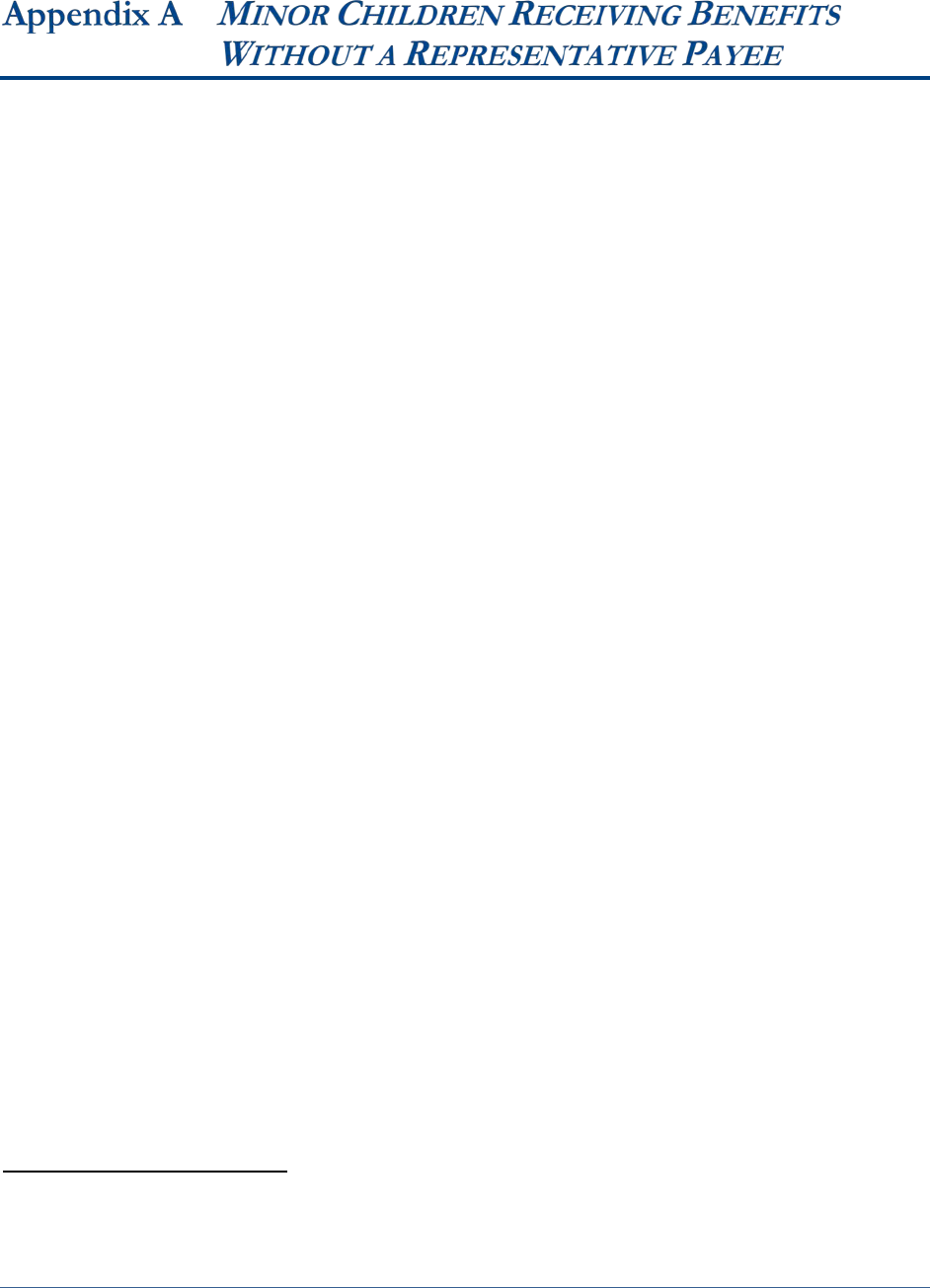
Minor Children Receiving Social Security Benefits Without a Representative Payee (A-13-17-50169) A-1
–
In May 2011, we issued a report on Minor Children Receiving Benefits Without a Representative
Payee.
1
Our objective was to determine whether the Social Security Administration (SSA)
appointed representative payees for minor children in accordance with its policies.
Findings and Recommendations
SSA did not always appoint representative payees for minor children in accordance with its
policies. We estimated the Agency did not appoint representative payees, as required, for
approximately 3,200 children under age 18 who had received approximately $66.2 million in
benefits. Since these children did not have representative payees, the Agency was not able to
monitor how the benefits were spent. The majority of the problems were due to employee
processing errors.
We made five recommendations to address our findings, and the Agency generally agreed with
each. Below are our recommendations and actions SSA took to address each.
1. Remind employees to follow policies and procedures when issuing direct payments to
children under age 18. Specifically, (1) appoint representative payees for all children under
age 15 and (2) document capability determinations for children ages 15 through 17 who are
deemed capable of receiving direct payment.
Agency Response: The Agency published an Administrative Message
2
to remind employees
to appoint a payee for children under age 15 and to document capability for children ages
15 to 17 on June 17, 2011.
2. Follow up on the 14 children under age 15 whose benefit payments were suspended pending
appointment of payees and determine whether any of the cases should be referred to our
Office of Investigations for further action.
Agency Response: SSA reported that all regions had taken action to develop and document
cases in their jurisdiction regarding the 14 children under age 15 whose benefits were
suspended. The Agency also indicated representative payee selections, suspensions, and
referrals were made accordingly. We confirmed SSA appointed representative payees for
11 children, but the Agency later terminated benefits for 8 with only 3 children still receiving
benefits as of September 2018. Of the 14, as of September 2018, 9 children were 18 or older
and therefore no longer required representative payees because they were no longer minor
1
SSA, OIG, Minor Children Receiving Benefits Without a Representative Payee, (A-13-10-10104), (May 2011).
2
SSA, AM-11071, Issuing Direct Payment to Children and Documenting Capability-Reminders, (June 17, 2011).

Minor Children Receiving Social Security Benefits Without a Representative Payee (A-13-17-50169) A-2
children. Additionally, SSA referred five cases to the Office of Investigations, which found
the allegations did not meet case opening guidelines.
3. Identify pending representative payee applications for children under age 15 before
completing [Representative Payee System] database cleanups. If follow-up actions are
required, refer the identified applications for additional review.
Agency Response: The Agency reported it identified the pending representative payee
applications before it completed scheduled database cleanups.
4. Determine whether there is a cost-effective method for identifying undocumented
representative payees and requiring such payees to account for the use of benefits they
receive on the behalf of child beneficiaries.
Agency Response: SSA published an Administrative Message to remind technicians how to
get proper documentation on accounting forms from undocumented representative payees.
5. Determine whether it is cost-effective to periodically review a list of children under age 18 in
direct pay status as a monitoring control. At a minimum, we believe all children under
age 15 without a representative payee should be identified on a periodic basis so that payees
can be appointed.
Agency Response: The Agency reported it reviewed its policies and procedures and, given
the budget climate and other pressing systems and operational activities in the representative
payee area, it did not believe it would be cost-effective to periodically review the cases of
children under age 15 without representative payees. However, SSA published an
administrative message
3
to remind employees about the need to select representative payees
as soon as possible for children under age 15.
3
SSA, AM-12084, Reminder-Issuing Direct Payments for Child Beneficiaries Under Age 18 and Reinstating
Benefits Timely (July 20, 2012).

Minor Children Receiving Social Security Benefits Without a Representative Payee (A-13-17-50169) B-1
– SCOPE AND METHODOLOGY
To accomplish our objective, we:
Obtained and reviewed applicable Federal laws and regulations and the Social Security
Administration’s (SSA) policies and procedures.
Reviewed a prior Office of the Inspector General report on minor children receiving benefits
without representative payees.
Met with personnel from SSA’s Office of the Deputy Commissioner for Operations.
Obtained and analyzed electronic data extracts from SSA’s Master Beneficiary and
Supplemental Security Records. See Appendix C for detailed information.
Performed data mining to identify two mutually exclusive sampling frames for review. See
Appendix C for detailed information.
One sample frame consisted of 709 minor children under age 15 who had no
representative payees as of April 2017.
Another sample frame consisted of 1,273 minor children between ages 15 and 17 and
5 months who had no representative payees as of April 2017.
Submitted information for 709 minor children under age 15 without representative payees to
the Agency for review.
Reviewed information for 118 of the 709 minor children under age 15 and determined
whether individuals other than the child were receiving payments. For these items, we
examined information from the Treasury Check Information System to determine who
received the benefits. Additionally, we reviewed SSA’s Electronic Representative Payee
System (eRPS) to determine whether SSA appointed representative payees for children
before our submitting information for the 709 minor children under age 15.
Determined whether we identified items in this sampling frame in the prior audit.
1
Selected a random sample of 50 minor children between ages 15 and 17 and 5 months and
50 minor children under age 15 without representative payees and determined compliance
with SSA’s policies.
For sample items, we examined information from eRPS, the Claims File User Interface,
and the Modernized Supplemental Security Income Claims System. Additionally, we
reviewed queries from SSA’s Master Beneficiary and Supplemental Security Records.
We reviewed this information to determine whether SSA complied with policies and
procedures and appointed representative payees for minor children when required.
Determined whether we identified items in this sampling frame in the prior audit.
2
1
SSA, OIG, Minor Children Receiving Benefits Without a Representative Payee, A-13-10-10104 (May 2011).
2
See Footnote 1.

Minor Children Receiving Social Security Benefits Without a Representative Payee (A-13-17-50169) B-2
Calculated payments for minor children who received benefits without representative payees
when SSA policy required the children have representative payees.
We conducted our review from June 2017 through September 2018 at SSA Headquarters in
Baltimore, Maryland. The principal entity audited was the Office of the Deputy Commissioner
for Operations.
We determined the computer-processed data used for this audit were sufficiently reliable to meet
our audit objectives. Further, any data limitations were minor in the context of this assignment,
and the use of the data should not lead to an incorrect or unintentional conclusion.
We conducted this performance audit in accordance with generally accepted government
auditing standards. Those standards require that we plan and perform the audit to obtain
sufficient, appropriate evidence to provide a reasonable basis for our findings and conclusions
based on our audit objectives. We believe that the evidence obtained provides a reasonable basis
for our findings and conclusions based on our audit objectives.
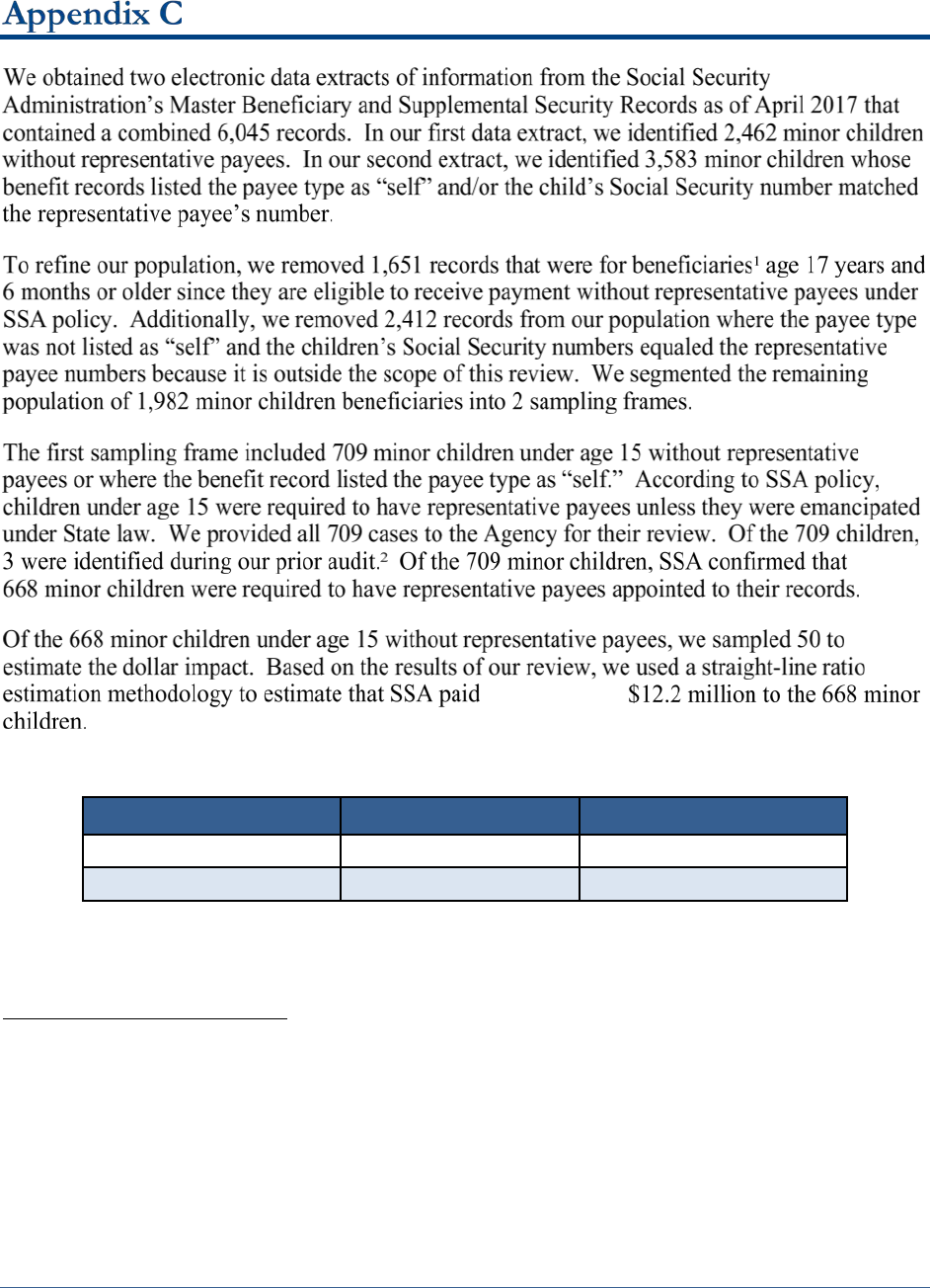
Minor Children Receiving Social Security Benefits Without a Representative Payee (A-13-17-50169) C-1
– SAMPLING METHODOLOGY AND RESULTS
approximately
Table C–1: Straight-line Estimation for Sample Frame 1
Description Sample Cases 668 Beneficiaries
Sample Size
50
668
Payments
$914,291
$12,214,921
3
1
We use the term “beneficiary” generically in this report to refer to both Old-Age, Survivors and Disability
Insurance beneficiaries and Supplemental Security Income recipients.
2
SSA, OIG, Minor Children Receiving Benefits Without a Representative Payee, A-13-10-10104, (May 2011).
3
To calculate the estimated amount of benefits, we determined the average payment per beneficiary for the
50 sample cases of minor children under age 15 ($914,290.50 / 50 = $18,285.81). We then multiplied the average
payment per beneficiary by the number of minor children under age 15 who are required to have representative
payees ($18,285.81 x 668 = $12,214,921.08).
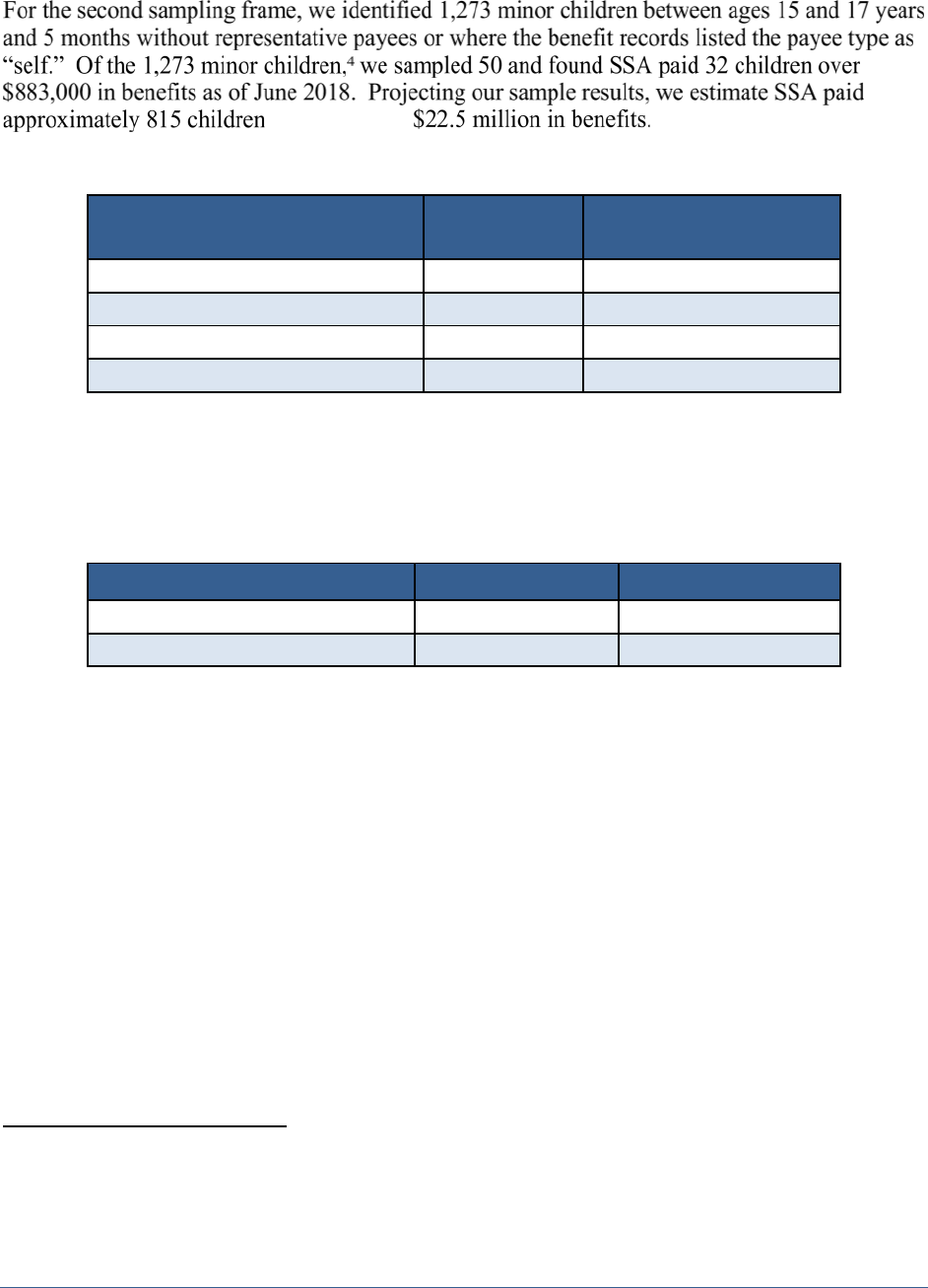
Minor Children Receiving Social Security Benefits Without a Representative Payee (A-13-17-50169) C-2
approximately
Table C–2: Projections for Sample Frame 2
Description
Number of
Children
Amount of Payments
Sample Results
32
$883,707
Point Estimate
815
$22,499,184
Projection Lower Limit
658
$15,292,465
Projection Upper Limit
955
$29,705,903
Note: All statistical projections were calculated at the 90-percent confidence level.
Additionally, we used a straight-line ratio estimation methodology to estimate that SSA did not
properly document capability determinations for 356 children.
Table C–3: Straight-line Estimation for Sample Frame 2
Description
Sample Cases
Beneficiaries
Sample Size
50
1,273
Results
14
356
5
4
We identified six children from the prior audit in this group of beneficiaries.
5
To calculate the estimated amount of beneficiaries whose capability determinations SSA did not properly
document, we first calculated 1,273 x 14 = 17,822. We then divided the 17,822 by the number in our sample size
(17,822 / 50 = 356.44). We rounded the 356.44 down to 356.

Minor Children Receiving Social Security Benefits Without a Representative Payee (A-13-17-50169) D-1
– AGENCY COMMENTS
SOCIAL SECURITY
MEMORANDUM
Date:
May 6, 2019 Refer To: S1J-3
To:
Gail S. Ennis
Inspector General
From:
Stephanie Hall
Acting Deputy Chief of Staff
Subject:
Office of the Inspector General Draft Report “Follow-up: Minor Children Receiving Social
Security Payments Without a Representative Payee” (A-13-17-50169) -- INFORMATION
Thank you for the opportunity to review the draft report. Please see our attached comments. We
also provided technical comments at the staff level.
Please let me know if we can be of further assistance. You may direct staff inquiries to Trae
Sommer at (410) 965-9102.
Attachment

Minor Children Receiving Social Security Benefits Without a Representative Payee (A-13-17-50169) D-2
SSA COMMENTS ON THE OFFICE OF THE INSPECTOR GENERAL DRAFT
REPORT, “MINOR CHILDREN RECEIVING SOCIAL SECURITY PAYMENTS
WITHOUT A REPRESENTATIVE PAYEE” (A-13-17-50169)
GENERAL COMMENTS
We are continuing our efforts to implement the changes required by the Strengthening
Protections for Social Security Beneficiaries Act of 2018. With the enactment of the new law,
two Sections (Section 201: Advance Designation of Representative Payee and Section 204:
Reassessment of Payee Selection and Replacement Policies) of the law affect our current policies
on capability determination for minor children, as well as determining or adjudicating the proper
selection of a representative payee. Emancipated minors (below age 18) will have the ability to
make an advance representative payee designation that will take precedence over the current
order of preference. We expect to publish updated instructions and provide training to field
office staff on the changes by the end of fiscal year 2019.
Our responses to the recommendations are below.
Recommendation 1
Direct employees to (1) comply with policies for appointing representative payees for minor
children, (2) document capability determinations, and (3) adjudicate representative payee
applications properly.
Response
We agree.
Recommendation 2
Implement a process to periodically identify all children under age 17 and 5 months being paid
directly; and determine and document whether the Agency needs to appoint representative
payees.
Response
We agree.

MISSION
By conducting independent and objective audits, evaluations, and investigations, the Office of
the Inspector General (OIG) inspires public confidence in the integrity and security of the Social
Security Administration’s (SSA) programs and operations and protects them against fraud,
waste, and abuse. We provide timely, useful, and reliable information and advice to
Administration officials, Congress, and the public.
CONNECT WITH US
The OIG Website (https://oig.ssa.gov/) gives you access to a wealth of information about OIG.
On our Website, you can report fraud as well as find the following.
• OIG news
• audit reports
• investigative summaries
• Semiannual Reports to Congress
• fraud advisories
• press releases
• congressional testimony
• an interactive blog, “
Beyond The
Numbers” where we welcome your
comments
In addition, we provide these avenues of
communication through our social media
channels.
Watch us on YouTube
Like us on Facebook
Follow us on Twitter
Subscribe to our RSS feeds or email updates
OBTAIN COPIES OF AUDIT REPORTS
To obtain copies of our reports, visit our Website at https://oig.ssa.gov/audits-and-
investigations/audit-reports/all. For notification of newly released reports, sign up for e-updates
at https://oig.ssa.gov/e-updates.
REPORT FRAUD, WASTE, AND ABUSE
To report fraud, waste, and abuse, contact the Office of the Inspector General via
Website: https://oig.ssa.gov/report-fraud-waste-or-abuse
Mail: Social Security Fraud Hotline
P.O. Box 17785
Baltimore, Maryland 21235
FAX: 410-597-0118
Telephone: 1-800-269-0271 from 10:00 a.m. to 4:00 p.m. Eastern Standard Time
TTY: 1-866-501-2101 for the deaf or hard of hearing
